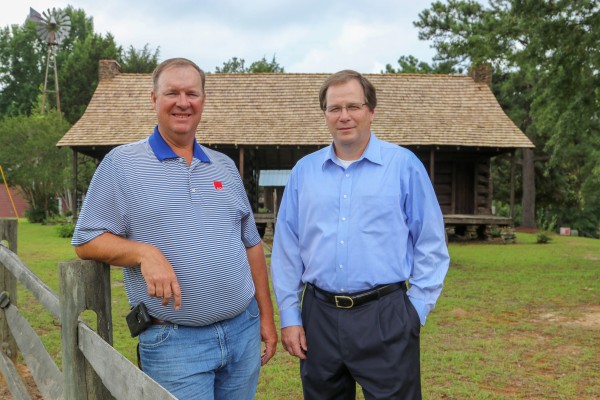Alfa Donation Helps Pioneer Museum Preserve The Past

A familiar sight greets beach-bound travelers, snowbirds and locals on U.S. Highway 231 just north of Troy — a cluster of wood buildings, stuffed-to-the-brim general store, farm implements and a black-as-night locomotive.
The Pioneer Museum of Alabama has preserved the past since 1971, and thanks to a donation from the Alfa Foundation, its work educating students and lending trips down memory lane is headed back to tip-top condition.
“Every museum has its own challenges,” said Jeff Kervin, museum board chairman. “We’re trying to preserve items that are antiques to begin with, which is why partnerships with organizations like Alfa are so important.”
The Alfa Foundation is the philanthropic arm of Alfa Insurance. Its $21,750 donation helped re-roof the museum’s dogtrot cabin with cedar shake shingles — similar to the original ax-split roofing.
“We’re proud to help maintain this piece of history,” said Steve Stroud, Pike County Farmers Federation president and a Alabama Farmers Federation and Alfa state board member. “The dogtrot cabin is integral to the museum, showcasing how Alabama pioneers lived. It’s imperative to teach the next generation how hard work and resourcefulness laid the foundation for modern society.”
At the museum, director Barbara Tatom’s roots run deep. Clad in her Junior Girl Scout uniform, Tatom was present for the museum’s ribbon cutting where founder Curren Farmer actually severed a plow line — nearly 50 years ago.
“I remember the excitement when Mr. Farmer started collecting items,” Tatom said. “We want to draw all ages to our museum. Older generations can share their knowledge and memories with younger students and families who visit.”
As director, she’s revamping the museum, which covers facets of pioneer life — cast-iron kitchen gadgets, quilts, furniture, corn-husk toys, musical instruments, hand-stitched clothing and Native American interactions. In the general store, décor reminds visitors it was a common gathering spot, serving as post office and a market for shoes, dry goods, tools, fabric and even caskets. An authentic schoolhouse, tenant house, corn crib and smokehouse dot the museum property. A nature trail winds through the acreage, while a covered bridge leads to a period church.
Outdoor occupations such as distilling turpentine, blacksmithing, logging and milling are featured, as are modes of transportation, like buggies, a horse-drawn hearse and wagons. Farmer’s inspiration for the museum included plows and other farm equipment, which round out the displays.
“I look at the equipment and am amazed by our ancestors’ ingenuity,” Tatom said. “Visitors are, too. People spend anywhere from 30 minutes to three hours with us.”
Throughout the year, the museum’s picnic areas and an amphitheater set the stage for reunions, students, church groups and weddings. Some attendees of the Federation’s Commodity Producers Conference Aug. 3 will soak up Alabama’s agricultural history during museum tours.
“We hope visitors see the back-breaking work it took to produce food to survive and leave here with a greater appreciation for what they have,” Kervin said.
